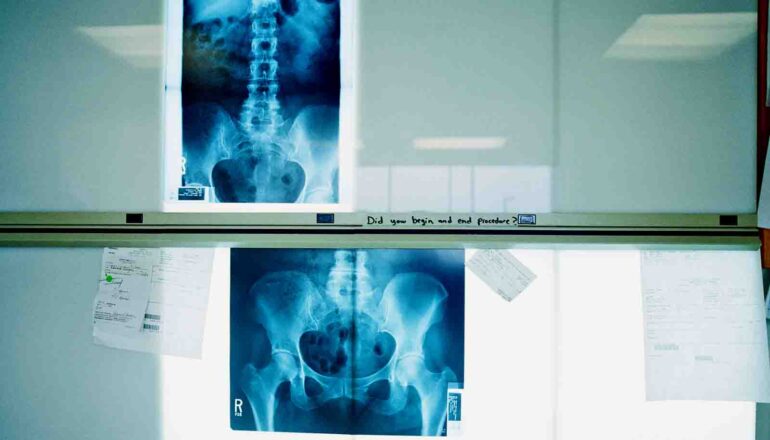
A low-tech electrode array can effectively stimulate muscles in the legs of people with spinal cord injuries, a proof-of-concept study shows.
A spinal cord injury is a life-altering event, and the effects, such as muscle weakness and paralysis, can dramatically disrupt a person’s life. While there is no cure for paralysis, there has been some progress in developing potential treatment options to improve symptoms. Still, much of it remains out of reach to many patients. A person with a complete spinal cord injury may benefit from a spinal cord stimulator, but cost, safety, and patient willingness to undergo surgery are among the barriers to treatment.
Now, a group of engineers from Washington University St. Louis, led by Ismael Seáñez, an assistant professor of biomedical engineering at the McKelvey School of Engineering and of neurosurgery at the School of Medicine, has begun work on a low-cost, noninvasive approach to spinal cord stimulation that offers affordable hope to patients. Their work appears in the Journal of Neural Engineering.
One kind of stimulation, called epidural spinal cord stimulation (eSCS), implants electrodes underneath the skin near the spine and sends electrical signals to stimulate specific muscle groups. In a spinal cord injury, neuronal communication from the brain to muscles in the body may be interrupted, but the connections from the spinal cord to the muscles themselves remain intact. ESCS can get extremely close to the spine and essentially allow the weakened signals from the brain to reach their targets in the spinal cord to reactivate the muscles.
Because of how close that implant can get to the spine, “We can be very particular about what muscles we’re targeting,” Seáñez says.
ESCS has been available since the 1960s for pain management, and over the last decade has been used successfully to produce muscle movements for activities as complex and dexterous as biking, swimming, and kayaking. However, the surgery required for it, the large team of experts needed to implant it, and a cost in the tens of thousands of dollars, can keep it out of reach for many.
Instead, Seáñez and his lab turned to transcutaneous SCS (tSCS). Instead of a surgical implant directly into the body, tSCS uses a series of electrodes placed on the skin to deliver electrical pulses with the aim of stimulating specific muscle groups. Researchers have studied tSCS for muscle stimulation for years, in a variety of configurations with both single electrode and multi-electrode arrays, but before this work there had been no comprehensive study evaluating how to best use tSCS for muscle stimulation.
That lack of detailed analysis has held tSCS back. For instance, a single electrode configuration gives a patient a very general stimulation that activates essentially all motor neurons below the spot on the spinal cord being stimulated. So instead of specifically flexing the hip, for example, a patient might just jerk the whole leg. With a focused study, Seáñez hypothesized that they could create a set of guidelines that can be used by medical professionals.
Seáñez’s team recruited 16 participants without spinal cord injury to test their tSCS setup. They found that instead of just one electrode positioned on the skin near the spine, using multiple electrodes, three on each side of the spine and two on either side of the abdomen to close the circuit, was the most effective configuration. This gave them more specific control of muscles in selected regions, such as the hip or the ankle. The group tested a variety of electrode setups, and through repeated testing, they calculated a probability chart that pinpoints the best spots along the spine to place electrodes and the chances of activating specific muscles electrodes will have. Using that experimentation, Seáñez created a map of the spinal cord that illustrates where along the body, in a hypothetical rehabilitation scenario, medical professionals should target to stimulate specific muscle groups.
This work makes tSCS a real alternative to more expensive therapies. A surgically implanted spinal stimulator can cost more than $18,000, according to Seáñez. A tSCS unit is comparable in cost and scale to a transcutaneous electrical nerve stimulation (TENS) device, a pain-relief device that delivers small electrical charges and can be bought at any pharmacy for about $40.
Although he envisions tSCS becoming part of the standard rehabilitation process, Seáñez cautions against seeing their work as anything but a proof of concept.
“It’s an exciting first step, but it’s just a neurophysiological confirmation of the neural circuits we can target,” he says. “The next step is to investigate whether we can actually improve people’s capacity to move.”
This research had support from the Eunice Kennedy Shiver National Institute of Child Health & Human Development of the National Institutes of Health; the National Institute of Neurological Disorders and Stroke of the National Institutes of Health; and Washington University’s McDonnell Center for Systems Neuroscience Small Grants Program.
Source: Dan Samorodnitsky for Washington University in St. Louis
The post Can this low-cost therapy treat spinal cord injuries? appeared first on Futurity.
from Futurity https://ift.tt/7ksMTz9
No comments:
Post a Comment